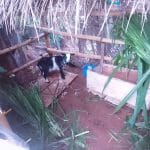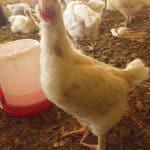By FarmersJoint in Livestock Farming 
Do you have pregnant sheep, goats or cows that fall sick before or after delivery? Saliva drips out of their mouth, they stop defecating or urinating, they find it difficult to stand or walk. The cause might be milk fever. Read to find out more.
Milk fever or hypocalcemia arises when animals are unable to mobilise sufficient calcium from the bones or diet when there is high demand for calcium, leading to low blood calcium level. Calcium is in high demand during late pregnancy and some days after birthing. For cows, milk fever mainly occur after birth but for goats and sheep it mainly occur before birth, during late pregnancy period (i.e. 6 weeks before birthing). Occurrence after birth isn’t common in sheep and goats.
Generally, milk fever can occur at any time from 6 weeks before to 10 weeks after birthing. Milk fever can also occur when certain compounds
>>>>>> [Read more…] <<<<<<
By FarmersJoint in Livestock Farming 
Urea molasses mineral block is a cheap supplemental block that is used to increase the nutritional qualities of low-quality feeds for ruminants (goats, sheep and cattle). It is a good source of protein, energy and minerals. Low quality feeds are cheap and abundant. Few examples include crop residues like wheat and rice straw, maize and sorghum stovers, beans plant and dry grasses. They are low in protein, vitamins, minerals and are hard to digest. Feeding these to ruminants result in sluggish growth, delayed maturation, longer pregnancy interval, poor milk yield etc.
But when you combine low quality feeds and UMMB, there will be increase in feed digestibility by up to 20 percent, increase in growth rate and increased feed intake by 25 to 30 percent. With UMMB, poor farmers don’t have to spend money on costly feeds like maize, soybeans meal, groundnut cake etc.
How to Make Urea Molasses Mineral
>>>>>> [Read more…] <<<<<<
By FarmersJoint in Livestock Farming 
If you are not careful, you will loose many newborn piglets before they are separated from their mother at 4 to 6 weeks of age. The guide below will help prevent or minimize pre-weaning death.
Piglets soundly asleep
During Birth: Baby pigs can be born dead. This may be due to diseases or lack of oxygen when the birth period is long. Long birth period can be caused by large number of piglets or high birth weight. Large number of piglets can also increase the number of piglets born weak. These weak piglets may then be more likely to starve, become crushed by their mother, or diseased.
If you want to reduce pre weaning mortality, you have to observe them as often as possible. Look out for the weak ones and help them to drink their mother’s milk.
Thermal Stress: Unlike many other animals, baby pigs don’t possess mechanisms
>>>>>> [Read more…] <<<<<<
By FarmersJoint in Livestock Farming 
Vaccines help to prevent or minimize the impact of viral diseases. They are important because viral diseases cannot be treated with drugs. They can only be prevented with vaccines. If a poultry farmer is not careful to follow certain rules, the vaccine he administer will fail to protect his birds from viral diseases. And when this happens, many farmers end up blaming the vaccine manufacturers.
Vaccines can be given to birds through drinking water, by injection, eye drop, spray etc. The most common route for broiler is via drinking water and wing web puncture (for fowlpox vaccine). For egg layers it is via drinking water, wing web puncture (for fowlpox vaccine) and injections. You can get sample vaccination/medication plans for layers and broiler below:
Vaccination/Medication Plan for Layers Vaccination/Medication Plan for Broilers
Below are rules that will help you prevent vaccine failure:
1. Vaccinate healthy birds
>>>>>> [Read more…] <<<<<<
By FarmersJoint in Livestock Farming 
Below is broiler medication and vaccination chart you can follow. Vaccinating your birds against viral diseases is very important because viral diseases are incurable. Vaccination will help to prevent or reduce the severity of viral diseases.
Medication on the other hand, is used to treat or prevent diseases caused by bacteria, fungi or protozoa. But if you follow good biosecurity measures, you can reduce the amount of medication you give.
Here goes the chart:
Day 1: Marek vaccine: This is usually given to the chicks at the hatchery.
On getting to your brooding pen, give them multivitamins and minerals in water. Provide broiler starter feed in enough feeder such that all of them can feed at the same time without struggle.
Day 2-4: Multivitamins and antibiotics. Recommended antibiotics include …..
Day 5: Gumboro vaccine via drinking water.
Day 7: Lasota for Newcastle disease
Day 10-12: Anti-coccidiosis drugs and
>>>>>> [Read more…] <<<<<<
By FarmersJoint in Poultry 
Litter beetles are those dark beetles you find in poultry houses, most especially in deep litter houses. They normally hide under everything – drinkers, feeders, stones, laying boxes that are on the floor, along the walls etc. In my early days of raising chickens, I totally ignore these beetles because I thought they were harmless. But are they harmless? They are VERY harmful!
Litter beetles
Litter beetles eat chicken feed, their larvae bore into insulations, woods etc, they climb into poultry feathers and bite them, sometimes killing weakened chickens and worst of all, they can carry a lot of poultry diseases!
The scientific name for these little destroyers is Alphitobius diaperinus. Locally, they can also be called darkling beetles, lesser mealworm, black beetles etc. They cause more problems in houses where the litter is allowed to build up without any effective control program in place.
>>>>>> [Read more…] <<<<<<
By FarmersJoint in Livestock FarmingWhen it comes to ruminant farming, Nigeria still practice the archaic system of nomadic grazing and cut-and-carry system from bushes. In countries like Kenya, livestock farmers grow grass to feed their animals. Many Nigerians may find this laughable but it is far better than what we’re used to.
Growing your own grass means that you are sure that feed supply will be enough to meet your animals’ need. It is also hygienic. When I was young, we had some goats and I was the one that feed them. I normally went to bushes to cut grass. One thing that worried me so much is the eye-sores I normally encounter. I would always have to cope with the sight of human feces here and there. In fact, that was the main thing that discouraged me from goat farming.
Cattle grazing close to farmlands
Now that I have discovered
>>>>>> [Read more…] <<<<<<
By FarmersJoint in Livestock FarmingPay a visit to fresh fruit and vegetable markets and slaughter houses and you’ll see how much food get wasted daily. Unknown to many, these wastes can easily be converted to nutritious meal for pigs, poultry, goats, sheep, cows, rabbits, and fish by a process called lactic acid fermentation. All you need is a lactic acid bacteria, a source of fermentable carbohydrate and time. Don’t mind the complex names, you can easily get all of them.
Fruits, vegetables, fish and slaughter house wastes has very high water content and that makes them highly perishable. They can be treated in various ways but those ways can hardly compete with fermentation – they may be composted (time consuming), used in vermiculture (growing of earthworm) or biogas digesters (why use a valuable waste when you can use manure instead?) or fed directly to animals (they may contain pathogens and pesticides. There is
>>>>>> [Read more…] <<<<<<
By FarmersJoint in PoultryWhen you get your day old chicks, it is important to do what is called “day old chick screening”. Day old chick screening has a lot of benefits that can save you from disaster. It helps you to know the right time to vaccinate your birds and tells you the right antibiotics to use.
Although there are established vaccination plans that will work for most people in an area, DOC screening is still important because Hatcheries can make mistakes. Some vaccination plans may tell you to vaccinate for Newcastle disease on day 7. But because of hatchery mistake, the chicks may actually need the vaccine on day 5 to prevent disaster. DOC screening will help you discover this.
Due to the cost of this screening (N7000 as of 2015), it may not be favorable to those who has less than 500 or 1000 chicks as the case may
>>>>>> [Read more…] <<<<<<
By FarmersJoint in RuminantThe Tumbukiza method, which originate from Kenya, has been known to improve grass yield (by about 2x) and drought tolerance. The grass will grow longer into the dry season before the leaves start dying off. This means that feed will still be available during part of the dry season. But with irrigation, dry season will lose its significance.
Tumbukiza MethodCourtesy of FAO.org
There are 2 types of Tumbukiza method: The round pit type and the rectangular pit type.
Round Pit Type: Dig a pit 60cm in diameter and 60cm deep, leaving 60cm space between the pits.
Rectangular Pit Type: Dig a pit 60cm deep and 60-90cm wide. The length of the pit will depend on the available land, but it should be as long as possible. Leave 90cm space between pits. Rectangular pits that are long make more economical use of land and are easier to
>>>>>> [Read more…] <<<<<<
|
Join the Forum Do you want to discover more great info like these?
Register for free and ask your question in our farming forum! Our knowledgeable members will have your questions answered.
FarmersJoint.com strives to maintain accurate and up-to-date information; however, mistakes do happen and we won't be held accountable for anything that result from the use of information provided in this site. If you would like to correct or update any of the information, please send us an e-mail. THANK YOU!
|





